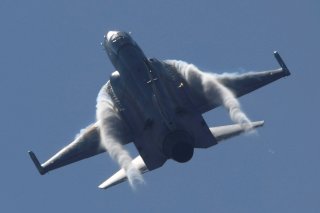China's Command and Control Strategy Looks Suspiciously Familiar
JADC2 could be considered “defining” in terms of how the Pentagon plans to win future wars. However, such a strategic approach may not be pursued by the U.S. alone.
China’s efforts to steal U.S. weapons technologies, innovations, and platform designs are both well known and well documented. But it is accompanied by an increasing commensurate effort to replicate emerging U.S. strategies, tactics, and warfare maneuvers.
The Chinese already appear to be copying the Pentagon’s ongoing effort to architect a multi-domain warfare synergy through air-sea drills and other kinds of war preparation exercises. A more recent effort, it seems clear, is an apparent attempt to copy what is arguably the most significant U.S. military program: Joint All Domain Command and Control (JADC2). The idea is to engineer a meshed network of dispersed yet securely connected combat nodes across a combat area. The intent of JADC2 is, among other things, oriented toward reducing sensor to shooter time to expedite a combat decision-making cycle and stay in front of an adversary.
This relies not only on transmitting information in a secure fashion but also executing data and information processing, organization, analysis, and data fusion. It could be described as information-driven warfare, an effort to cover dispersed and otherwise disconnected combat platforms or nodes, whether they be fighter jets, bombers, tanks, drones, or ground control centers, to one another in real-time. In order to do this, a vast amount of sensor data needs to not only be gathered but properly processed and analyzed so the most pressing and relevant details are identified and transmitted across the force according to mission needs and changing threats. This is part of why so much of JADC2 is being improved through the application of AI-empowered algorithms, computers, and databases.
JADC2 could be considered “defining” in terms of how the Pentagon plans to win future wars. However, such a strategic approach may not be pursued by the U.S. alone. Specifically, China’s well-known military modernization push now appears to be copying JADC2 or doing its own version in an effort to expand and expedite networking.
This Chinese concept, which very closely resembles the Pentagon’s JADC2, is discussed in a Chinese newspaper in the context of developing and deploying a new Airborne Warning and Control System (AWACS) airplane, something which is itself a copy of several U.S. surveillance planes such as the U.S. Navy’s E2D Hawkeye.
While discussing the maturation of China’s new AWACS, China’s Global Times newspaper quotes its military officials saying that AWACS will “likely not be one single early warning aircraft but a cluster of platforms that can accomplish different missions and build an information network.”
This concept sounds exactly like JADC2 as well as the U.S. Air Force’s Advanced Battle Management System.
“But war is not about just an individual aircraft, but a system, so there should be space, aerial, ground, maritime and underwater platforms integrated together and doing their job, Lu said, noting that this will enhance the joint combat capability based on an information network system,” Lu Jun, chief designer of China's KJ-2000 early warning aircraft, said as quoted in the Global Times.
However promising a combat strategy may appear, its execution is of course the true test of operational functionality in warfare. Networks need to be hardened, ranges need to be extended, gathered data and sensor information needs to be processed and numerous transport layer avenues of communication need to be refined, demonstrated, and ready for operations. This can be satellite communications (SATCOM) connectivity, GPS guidance, radiofrequency datalink information exchange, software-defined radio, or even newer possibilities such as optical or laser communication possibilities.
Kris Osborn is the defense editor for the National Interest. Osborn previously served at the Pentagon as a Highly Qualified Expert with the Office of the Assistant Secretary of the Army—Acquisition, Logistics & Technology. Osborn has also worked as an anchor and on-air military specialist at national TV networks. He has appeared as a guest military expert on Fox News, MSNBC, The Military Channel, and The History Channel. He also has a Master's Degree in Comparative Literature from Columbia University.
Image: Reuters

